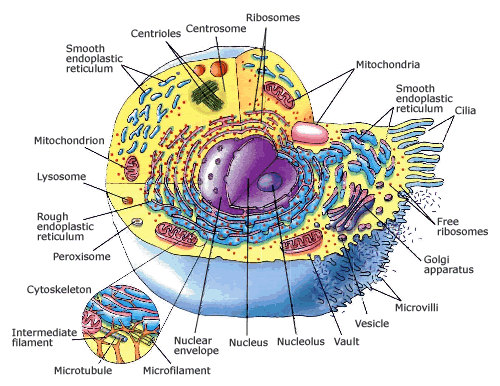
Plasma membrane
outer boundary of cells that controls
entry and exit of substances
attaches to other cells or intercellular
molecules;part of intercellular communication
and identification;catalyzes chemical reactions
cytoplasm
contains enzymes that catalyze the synthesis
and breakdown of molecules
cytoskeletons
support the cytoplasm and form centrioles,
spindle fibers cilia and flagella
provide structural support to cells
nuclear envelope
seperates nucleus from cytoplasm;allows movement
of materials into and out of nucleus
chromatin
DNA regulates protein synthesis and the
chem. reactions of the cell;DNA is the genetic or
hereditary material.
nucleolus
assembly site of large and small ribosomal units
ribosome
site of protein synthesis
rough endoplasmic reticulum
protein synthesis and transport to golgi apparatus
smooth endoplasmic reticulum
manufactures lipids and carbohydrates;detoxifies
harmful chemicals;store calcium
golgi apparatus
modifies proteins and lipids and packages them
into vescicles for distribution
secretory vesicle
carries proteins to cell surface for secretion
lysosomes
contains digestive enzymes
for food vacuoles
"suicide sac"
mitochondria
major site of ATP synthesis
centrioles
centers for microtubule formation;determine
cell polarity during cell division
spindle fibers
assists in the separation of chromosomes during cell
division
cilia
move materials over the surface of cells
flagellum
responsible for movement of sperm cells
microvilli
increase surface surface area of the plasma membrane
for absorption and secretion
Two Major Kinds of Cell
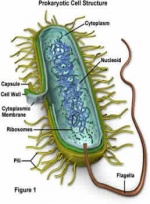
Prokaryotic Cell
Cells that do not have a cell membrane around their Nucleus. Example - Bacteria
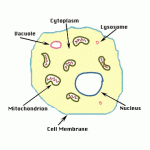
Eukaryotic Cell
Cells that have a membrane around their nucleus. Example - Plant and Animal Cells
Type Of Movement Across The Cell Membrane
Passive Transport
Passive transport is the movement of molecules
across the cell membrane and does not require energy.
It is dependent on the permeability of the cell membrane.
There are three main kinds of passive transport -
Diffusion, Osmosis and Facilitated Diffusion.
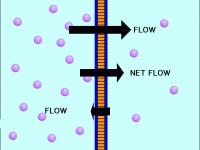
Diffusion
The movement of molecules from a region of higher
concentration to a region of lower concentration.
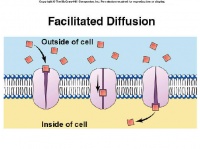
Facilitated diffusion
This process does not require ATP but does require cell membrane
proteins which are called carrier proteins to carry the molecules
across the cell membrane from an area of higher concentration
to an area of lower concentration.

Osmosis
The movement of water across a semi permeable membrane.
Osmosis is the movement of water (red dots) through a
semipermeable membrane to a higher concentration of
solutes (blue dots).
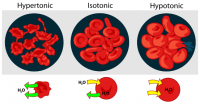
click image to enlarge
Hypertonic Solution
A Hypertonic solution contain a high concentration
of solute in relation to the solution within the cell
(e.g. the cell's cytoplasm).
When a cell is placed in a hypertonic solution, the water
diffuses out of the cell, causing the cell to shrivel up.
Hypotonic Solution
A hypotonic solution contain A solution
with a lower salt concentration than in normal cells
When a cell is placed in a hypotonic solution,
the water diffuses into the cell, causing the
cell to swell and possibly explode.
Isotonic Solution
A solution that has the same salt concentration
as the normal cells of the body and the blood.
When a cell is placed in an isotonic solution,
the water diffuses into and out of the cell at the same
rate. The fluid that surrounds the body cells is isotonic.
Active Transport
Active Transport requires the cell to use energy,
usually in the form of ATP.
Active Transport creates a charge gradient
in the cell membrane. For example in the mitochondrion,
hydrogen ion pumps pump hydrogen ions into the intermembrane
space of the organelle as part of making ATP.
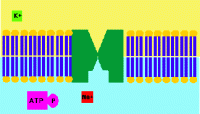
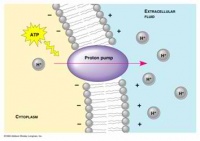
Active Transport keeps unwanted ions or other molecules out of the
cell that are able to diffuse through the cell membrane.
Active transport uses energy to send substances against
the direction they would travel by simple diffusion:
that is from a region of low concentration to a region
of high concentration.
Moving other Materials and Substances
into and out of the cell
ENDOCYTOSIS and EXOCYTOSIS
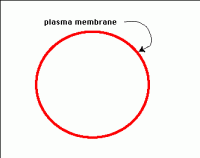
ENDOCYTOSIS
Endocytosis (Endo (within) cytosis (cell) )
is a process in which a substance (e.g. proteins)
gains entry into a cell without passing through
the cell membrane.
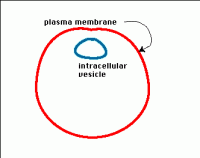
EXOCYTOSIS
Endocytosis (Exo (exit) cytosis (cell) ) is a
process in which a substance is exited from the cell
without passing through the cell membrane.
Examples of thigs that migh be exited include
secretion of proteins like enzymes, hormones
and antibodies.
Phases Of Mitosis
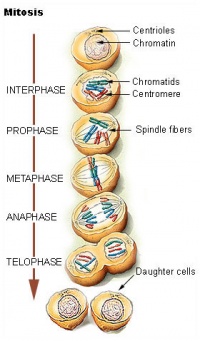
click image to enlarge
1. Interphase
DNA has replicated, but has not formed
the condensed structure of chromosome.
They remain as loosely coiled chromatin.
The nuclear membrane is still intact
to protect the DNA molecules from undergoing mutation.
2. Prophase
The DNA molecules progressively shorten and
condense by coiling, to form chromosomes.
The nuclear membrane and nucleolus are no longer visible.
The spindle apparatus has migrate to opposite poles of the cell..
3. Metaphase
The spindle fibres attach themselves to the centromeres of
the chromosomes and align the the chromosomes at the equatorial plate.
4. Anaphase
The spindle fibres shorten and the centromere splits,
separated sister chromatids are pulled along behind the centromeres.
5.Telophase
The chromosomes reach the poles of their respective spindles.
Nuclear envelope reform before the chromosomes uncoil.
The spindle fibres disintegrate.
Protein Synthesis,Transcription and Translation
Steps in Protein Synthesis:
STEP 1: The first step in protein synthesis is the transcription of mRNA
from a DNA gene in the nucleus. At some other prior time, the various
other types of RNA have been synthesized using the appropriate DNA.
The RNAs migrate from the nucleus into the cytoplasm.
STEP 2: Initiation:
In the cytoplasm, protein synthesis is actually initiated by the AUG
codon on mRNA. The AUG codon signals both the interaction of the ribosome
with m-RNA and also the tRNA with the anticodons (UAC). The tRNA which
initiates the protein synthesis has N-formyl-methionine attached.
The formyl group is really formic acid converted to an amide
using the -NH2 group on methionine (left most graphic)
The next step is for a second tRNA to approach the mRNA (codon - CCG).
This is the code for proline. The anticodon of the proline tRNA
which reads this is GGC. The final process is to start growing peptide
chain by having amine of proline to bond to the carboxyl acid group of
methinone (met) in order to elongate the peptide.
STEP 3: Elongation:
Elongation of the peptide begins as various tRNA's read the next codon.
In the example on the left the next tRNA to read the mRNA is tyrosine.
When the correct match with the anticodons of a tRNA has been found,
the tyrosine forms a peptide bond with the growing peptide chain .
The proline is now hydrolyzed from the tRNA. The proline tRNA now moves
away from the ribosome and back into the cytoplasm to reattach another
proline amino acid.
Step 4: Elongation and Termination:
When the stop signal on mRNA is reached, the protein synthesis is terminated.
The last amino acid is hydrolyzed from its t-RNA.
The peptide chain leaves the ribosome. The N-formyl-methionine that was used
to initiate the protein synthesis is also hydrolyzed from the completed peptide
at this time.
The ribosome is now ready to repeat the synthesis several more times.
<<RETURN TO TOPICS>>